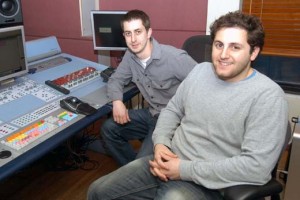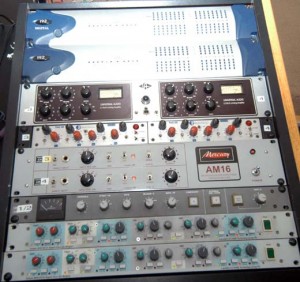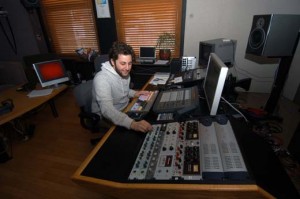The Art of VO Production: Pomann Sound Breaks it Down, Step by Step
MIDTOWN, MANHATTAN: Voice is sooooo choice.
Audio post houses throughout New York City amp up demand for their studios via world-class mixing and sound design, but most of them will admit that if they can’t record a top-quality voiceover (VO) – or 1,000,000 of them – they may as well close up shop tomorrow.
No question, post houses from the Bronx to Bensonhurst can cleanly capture a VO track for radio, TV, ADR, online media, or corporate video applications. The challenge is finding facilities that think the act is interesting – many audio engineers have little to say about fulfilling this deceptively uncomplicated function.
Not so at Pomann Sound, the midtown audio post complex founded by Bob Pomann almost 30 years ago. In addition to thousands of radio, TV, and Web assignments, their VO/sound design/mixing portfolio includes countless commercials, documentaries, films, audio books, and video games – including over 800 animated episodes which include the Emmy Award-Winning Disney series Doug.
A brief glimpse of their client list includes Ogilvy & Mather, McCann Erickson, TBWA Chiat Day, McGarry Bowen, Kaplan Thaler, Y&R, Sony Pictures, Warner Brothers Animation, Adult Swim, MTV, TV Land, Fisher Price, Random House, Hachette Book Group, Lucas Arts, and Lucas Film.
Now at the helm of a majority of Pomann’s projects are Sound Designer/Mixers Max Conklin and Justin Kaupp, a fast-moving tandem who get psyched when the topic is recording, editing and mixing VO. Not surprisingly, tackling the most complex of instruments — the human voice — requires attention to detail, from the moment Pomann wins the job until it’s approved by the client and ships out the door.
“Being able to make a good VO great is a rewarding feeling,” Conklin says. “On a technical level as well as from a performance aspect, there’s a lot that comes into play. A well-produced VO can get you to buy the latest phone service bundle in a radio or TV spot, or scare you half to death in a horror movie. These different situations can call for different editing and mixing techniques as well.
“There are certain objective questions you always have to ask yourself: ‘Do I de-breath this line or does it add to the performance?’ ‘Are the words and intention clear to a first time listener?’ and ‘Do the music and SFX support the VO rhythmically or is something clashing in the mix?’”
Conklin and Kaupp broke down their approach to a full-blown VO assignment, step by step. Read on to see a 360 degree view of how VO really goes down.
Stage 1: Getting Started
“At Pomann Sound we have a system of creating what we call ‘prebuilds.’ Which typically are scratch tracks of an entire spot—music, sound effects, and VO—that we can use when building the final spot, saving the client a lot of time in the end.
“We can cater our build to radio or TV and start plugging in select takes on the fly. With radio especially, this is essential to give the client an idea of how we would tell their story in 30 or 60 seconds.
“The ground-up approach for building spots tends to give us a more authentic and unique sound. It’s easy to pull an ambiance effect for any given situation, but why not cater it to the specific needs of the story and record exactly what the script calls for?”
Stage 2: Casting
“Castings tend to take about a day and we can cover up to three or four scripts at a time. When an actor steps into the booth to read for the first time we get a feel for what they might do with the script that we may not have thought of yet. After a few takes our casting director can direct them into a place that will meet the clients’ criteria.
“Having a skeleton of the spot – the prebuild– ready during a casting session helps us direct the talent to do what the spot requires in a given amount of time. It allows us to go into a casting with timings; not just from start to finish, but where certain punch lines need to hit. When we know our limitations, we know how much the talent can play with the copy. On the other hand sometimes the actors go in a different direction and influence the way we make our prebuild.
“Besides the obvious qualities like having the right voice and being a good actor, it seems the actors who book the jobs are always the ones who most ‘get’ the script. They know how to direct themselves and how to deliver the message.”
Stage 3: Recording the VO
“During the mix process we want total control, which means we’re doing very little if anything to the signal during the actual record. This is especially the case when we work on a project that goes on for a long period of time.
“For example, we’ve recorded and edited over 50,000 lines of dialogue for the new Star Wars: The Old Republicvideo game. The dialogue has to sound consistent from start to finish; meaning what we recorded last month has to match the recordings from when we first started the casting process in 2006. The only way to ensure this happens is to make sure we all follow the same specs and don’t try to EQ anything too much before it’s put ‘to tape.’
“Most of the time, the only parts of the signal we filter out are the unnecessary frequencies below 60 Hz and above 20 kHz. We always keep a compressor in the signal chain too, but that’s just for safety—we don’t want to see the needle jump too much.
“It also depends on the actor and the project. Recording a deep growling voice for a movie trailer will require a different microphone, placement, and processing than, say, a quiet, heartfelt whisper about a new romance novel.
“Our go-to microphone is a Neumann TLM170, but we also like to use a Sennheiser shotgun or our Neumann U87 depending on what we want in the end. Sometimes it’s overkill but we’ll use multiple mics and pick and choose. It’s always different.”
Who’s On Board for the Record:
“Most of the time the people in the studio for the actual recording are the engineer, assistant engineer, talent — sometimes two or three at a time — writers, creative directors, producers, and the client or representatives of that particular brand. Other times it’s just us and the actor. In those situations, we can patch in the clients via phone and they can listen and comment.
“Our role as an engineer is very different from session to session. Sometimes the director looks to us to translate the clients’ needs to the talent, whereas other times we’re solely responsible for the quality of the recording and organization of materials. We tend to enjoy the situations where we get to be more hands-on because with the relationships we’ve developed, we have the experience to know what will or won’t work in the final product.”
Stage 4: Editing and Mixing
“Our job is to make sure that performance doesn’t suffer from the time constraints of the spot. Speech is musical by nature and when we’re required to fit a certain amount of copy in so many seconds we ensure cadence and inflections remain intact. This is something we have to be conscious of during the record as well as editing into the build.
“Mixing is always about balancing frequencies and the same is true for a VO. It needs to be clear and cut through a mix while at the same time allowing the listener to take in other elements such as music and sound effects. This can mean using an EQ to carve out a hole in the music for the VO to sit, or using chain compression on music and SFX.”
Stage 5: Revisions and Approval
“It’s a huge advantage time-wise to have the client in the room with us. If the client doesn’t want something to sound a certain way it can be dealt with on the fly. A lot of times that isn’t the case and we’ll post a file mid-day for review. The client then has to come back to us with their thoughts, which can range from immediate approval to last-minute copy changes.
“Also, when they’re in the studio with us, we can present the mix to them on multiple listening speaker sets; loud, quiet, stereo, mono, 5.1, etc… They can hear it every way possible as opposed to just their office computer.
“As far as revisions go, it’s easy for us to plug in different lines or tags even if time is tight. We have a good sense of what sounds too tight or has too many holes before the client hears it and we can deal with it in the editing process. There have been plenty of times we’ve had to use time compression on individual syllables or take out millisecond gaps between words to make it fit without sounding rushed. That’s when we turn to Avid X-Form and elastic audio. We like to think of the voice track as a malleable thing we can push and pull until it all makes sense to the ear.
“The hardest situation we encounter is when the client decides to add something that wasn’t included in the script and the talent has already been released. That’s the most in-depth editing we’re ever asked to do—splicing syllables together to form new words or phrases. Other times, for example, the client will want the music louder, which creates the challenge of getting the VO to cut. We can use harmonic exciters in this situation to give the VO added presence without actually raising the level.”
Stage Six: Final Delivery
“File organization is one of the most important parts of what we do. We need to make sure spots are slated and titled with the proper codes. Often we’re building multiple versions of a spot in the same session and they can be identical except for different price points or URLs.
“A lot of time goes into creating the different versions and we always need to be labeling, taking careful notes, and triple checking files before we send them out. The different versions might also have some serious differences in timing and instead of just speeding up the VO, we’ll go in and make minor timing tweaks to everything so that each spot sounds relatively cohesive.
“Specs are important to consider as well. With the new CALM act, we have to be very careful of how we mix and monitor. It isn’t about making everything loud anymore; it’s about carefully making every sound mesh well and output at the right level. And in the end, regardless of what file format the client requires, we want to save high quality mixes and splits for ourselves.”
VO Science: What’s Next
“It’s becoming more about the speed in which you can turn an idea into something tangible. More and more we see directors and producers listening in over a connection like ISDN and Skype, as technology becomes cheaper and more accessible.
“Often during ADR records we’ll have multiple talents recording from various cities simultaneously. This forces us to consider many factors such as delay compensation, signal routing and, in the end, making all of the actors sound like they’re in the same place talking to each other.”
And if You Can Perfect That VO Here…
Global connections may make VO an international collaboration, but NYC remains an extra-intensive arena to perfect the craft. “In New York you get to work with people who are at the top of their profession,” Justin Kaupp notes. “From the actors to the agencies, people want to make something they’re proud of, not just race to the end of a project.
“It keeps you on your toes as an engineer though. If you can’t keep up or find quick and creative solutions to issues that may arise, another engineer no more than a few blocks away will.”
— David Weiss











eric daye
January 24, 2012 at 3:48 am (13 years ago)Great piece! I admire the VO industry and have done some radio and think I could make a decent run of VO work career wise. Thanks for the tech info..